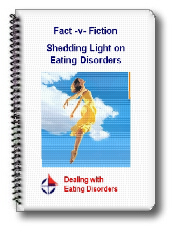|
Teaching Children Healthy Eating Habits
Although traditional eating disorders such as bulimia and anorexia most often develop among young adults, children are very impressionable and they can, as young as a few years old, be influenced by adults who have poor eating habits. If you are suffering from an eating disorder, take measures to treat the disease, if not for yourself, for your children. However, setting a good example may not be enough, since a number of outside sources, such as other children and the media, may influence your child. Teaching him or her about good eating habits and healthy body image is, therefore, very important. The most common eating problem among children is not eating too little or purging the body, as anorexics and bulimics do, but rather, the biggest problem is obesity.

Childhood obesity is on the rise, with twice as many children being obese today than a few short decades ago. Children are eating too much junk food—food that is high on calories and low on nutrients. To top this off, many childhood activities do not involve action—video games, computer time, and television watching all contributes to childhood obesity. Unfortunately, being overweight as a child can cause him or her to develop eating disorders as he or she grows. Poor body image is learned easily with culture influences such as the thin baby doll or the Greek God type bodies of modern sports stars. Talking to your child about body image and practicing healthy habits is extremely important to counteract these negative influences. Teach your child what eating disorders are and how they can be dangerous. Also teach the difference between “thin” and “healthy.” Treats high in calories or sugar should be for special occasions, not used as rewards. Instead, provide your child with multiple healthy snack choices such as fresh fruits and vegetables. Show them how these snacks can be just as yummy as cookies and potato chips. Also stress the importance of drinking water or sports drinks instead of punch. Your child, when old enough, should also learn about the food pyramid. He or she should learn how to balance a meal and why this is most healthy for a growing body. Have him or her help plan meals, using all food groups. As your child grows, be sure to reinforce positive body image. Young adult years can be stressful, so regulate your child carefully and if you suspect that an eating disorder has developed, talk to a medical professional to figure out the best course of action.
Vitamin & Nutrient Associations Even when we try to eat well, we're disadvantaged. The nutritional content of most food has been compromised over the years, not only by deficient soils and modern production, transportation, storage and processing methods, but also by the enormous amounts of chemical and artificial substances added to promote growth, storage life, taste and appearance. It's for this reason that more and more medical authorities are advocating the use of vitamin and mineral supplements. However, finding them in the right combination can be both confusing and costly for Children Healthy Eating. The nutrition products I am going to recommend you make use of knowledge gained from the botanical world's 6,000 year history. They incorporated health building nutritional herbs with the best modern technology to help our bodies cleanse and detoxify so that the cells - the tiniest living units - can be as fully nourished as possible. This allows the cells to grow, repair and to perform their functions with the best possible efficiency so that we feel and look better and are more able to prevent and fight disease. Once the body begins to clear itself of toxins it can more efficiently absorb nutrition.
You can visit our health food products page here: Herbalife Health Nutrition Supplements and learn more about our core nutrition program, the Cellular Nutrition Advanced Program and also check out these targeted products, Florafiber to replace your healthy flora and Aloe Vera Juice to help cleanse your system. More Resources available about eating disorders : Eating Away Pain: How Depression and Eating Disorders Go Hand in Hand These problems with food, weight, and body image can be extremely dangerous to a person’s health, both mentally and physically. Because those who suffer from eating disorders have poor body image, it is easy to see how eating disorders and depression work together.
You can visit our health food products page here: Herbalife Health Nutrition Supplements to learn more about some of the nutrition products mentioned in our recommendations above.
with you, so prevention is the only acceptable form of treatment.
Eating Disorders - Preventing Relapse: Just as Important as Treatment It is important to note that relapse prevention for eating disorders is different depending on each disorder. A good idea is to consult the professional that is aiding your recovery about the possibility and treatment involved with the potential relapse of an eating disorder.
Media and Culture Influences on Eating Disorders Eating disorders such as compulsive eating, anorexia, and bulimia, can be very dangerous for your body, possibly even resulting in death. There is no single cause for the development of an eating disorder. However, one of the most quickly and often cited reasons that eating disorders develop is the media. Culture influences—that is, how the body is portrayed in the media—can take a toll on impressionable minds, leading to eating disorders, especially among teens and young adults. Television is one form of media that portrays a thin body as beautiful. A multitude of reality shows have been introduced to the circuit in the past decade, and many of these, such as “Extreme Makeover” and “Celebrity Fit Club” portray thin as the only acceptable form of beauty. Even though, in recent years, these shows have been advocating fitness over thinness, people are still seeing the message that to be thin is to be beautiful. Even outside of the makeover programming realm, television perpetuates the myth that you need to be thin—most female television personalities are petite in size when compared to the average woman and most male television personalities are more muscular and lean than the average male. This concept is also true in the Hollywood world. Movie stars are typically slender, and some even have developed eating disorders of their own to stay thin. In magazine ads, models advertise alcohol and desserts, two very fattening items, yet they are very thin themselves, showing a distorted (if not downright confusing) view on body image. Designers target a thinner market in most cases, and even sports stars seem to be not only athletic, but also beautiful and thinner than the average regular athlete. Unfortunately, this cultural influence cannot be stopped and often perpetuates in daily life. Children at school tease heavier children, so kids learn at a young age that being thin is more desirable than being heavy-set, no matter how healthy you may be. Many adults contribute to this as well, being overly concerned with weight and passing this on to their children. Eating disorders develop when diet and exercise to not work, as is the case for many people. Bulimia, anorexia, and compulsive eating are all very dangerous diseases that can result in a number of health problems, as well as ultimately leading to death. Protect yourself and your loved ones by promoting good body image, healthy eating habits, and moderate amounts of exercise. Prevention is the first type of treatment for this dangerous situation, and although you may not be able to totally block out cultural influence, you can make a positive difference by teaching your children the difference between thin and healthy.
 to “Your Health Success” our monthly F’R’E’E’ Newsletter
Back to Top of Children Healthy Eating page
============================================================================ |


